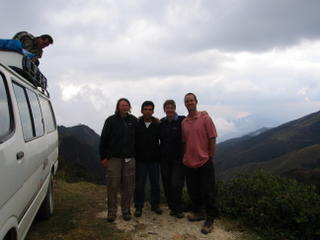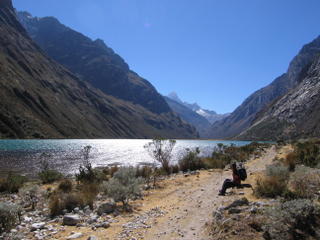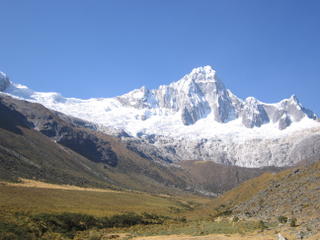 Ok before we get to that, I wanted you to see the fab four (sorry I know it's a bit dark, but it was cloudy, what can you do!) - Louise, Fernando, myself and Rob. I met these guys by chance in the hostal of a slightly loco woman in Trujillo and it was a match made in heaven. We were all going the same way and travelled together for the next week and a half with lots of laughs and fun. Thanks guys for a brilliant time, I miss you all.
Ok before we get to that, I wanted you to see the fab four (sorry I know it's a bit dark, but it was cloudy, what can you do!) - Louise, Fernando, myself and Rob. I met these guys by chance in the hostal of a slightly loco woman in Trujillo and it was a match made in heaven. We were all going the same way and travelled together for the next week and a half with lots of laughs and fun. Thanks guys for a brilliant time, I miss you all.Ok, back to the plot. I got off the bus after a day and a half of travel in Vilcabamba, "famed" (well National Geographic wrote about it) as the valley in which everyone lives for ever...over 100. It is an exceptionally pretty setting with lush verdant valley, banana plantations and tropical plants set against high brown mountains. I took myself to the Madre Tierra hostal as recommended by some people I met in Lima. On arrival they put a fruit drink in my hand and soothed all my concerns away before showing me my room. I stepped gratefully into a very hot shower and then ambled down for lunch. Some time later I had a fantastic massage in the Spa, rose petals laid out on the floor to create a path, jacuzzi before hand, it was bliss.
Then dinner, I'd bumped into an American girl earlier and we ate together, she proved to be the flakiest person I've spoken to on this trip, so that was hard work. Then we were rounded up by the owner to watch 10 minutes of fire dancing, v.skilful but not totally my cup of tea (for any Americans reading, this means it's not something I'm interested in!). Then the owner told us all about the UFO sightings in the Vilcabamba and Loja area and how they are planning a landing but US agents are coming to the area to foil the whole thing....And so to bed, fortunately a good night's sleep with no extra terrestrial visitors to disturb me.
The next morning I wandered in town and it felt a bit surreal, it's not quite like being in South America! A lot of foreigners have moved into the area and it shows, somehow it felt more like a movie set than a real life South American town. I'm sure that's not fair and there are lots of people leading ordinary lives but there's something different about this place. Perhaps it's the place to go if you want the climate and the isolation but don't want the hassle of South America!
I caught up on Internet and email a bit and then wandered back to the hostal and decided that although people rave about the area, it wasn't for me and I'd go off to Cuenca, the next big city in the morning! Which is where I am now and will be for a couple of days before I go on to Quito, a week tomorrow I'll be on my way to the Galapagos....yippee!


